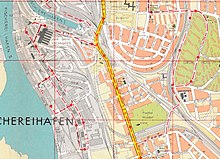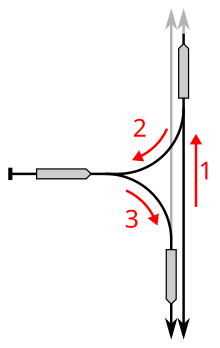Track triangle

(a veterinary fence runs across the picture )
A reversing triangle , rarely Bogendreieck , turning triangle , turning track triangle , inverse triangle , triangle bend or Y-turn called, is a turning system , are connected to each other in three lines. Two of the routes are always connected with a switch at each of the three contact points . The layout can be formed by single or multi-track routes.
Interpretation at crossover
When using multi-track lines, a distinction must be made between
- level design (with travel exclusions , but space-saving and inexpensive) or
- Level-free design (without travel exclusions, but space-consuming and cost-intensive, with overburden ).
The performance of the infrastructure depends on this.
Examples:
- The Darmstadt / Mannheim / Heidelberg track triangle in Mannheim-Friedrichsfeld is double-tracked everywhere and designed at the same level except in the direction of Heidelberg. Mannheim Friedrichsfeld-Süd is a stop on one edge of the Gleisdreieck.
- The Heidelberg / Karlsruhe / Stuttgart high-speed rail triangle north of Bruchsal is level-free only in the direction of Heidelberg and only has a single track on the opposite edge.
- In Bogendreieck Werdau three double-track main lines converge at the same level.
railroad
Track triangles were created on the railways but also in depots or freight yards. As a rule, a continuous straight track was connected to a butt track built at right angles to the straight track using three points using two curved tracks that were as symmetrical as possible. These triangular tracks were used to " turn " specially designed locomotives with tender , which could not be used regularly in reverse travel in train service, and were therefore needed in the vicinity of operating points where trains end or begin. Because of the relatively large amount of space required, track triangles are rare in Germany. With the introduction of the turntables in the railway depot, track triangles were largely dispensable. An even rarer (and considerably more complex) variant with the same function are track pentagons , whose space requirements are between that of the track triangle and the turntable.
Occasionally, passenger trains run in "reverse order " because, for example, B. had to " turn heads " with a previous diversion . These must then be turned in a large track triangle in order to be correctly positioned again at the beginning of the next mission, e.g. B. the ICE 1 on the north-south lines with the 1st class to the south (one turning ).
In West Saxony , the Werdau triangle is of supraregional importance for the Plauen (Vogtl) train station and the Zwickau Hbf . The Jüterbog – Röderau railway line also has an arched triangle, the junction at Zeithain to Dresden and Riesa .
Subway
Track triangles can also occur on subways. The best-known is still the Gleisdreieck underground station in Berlin, although the Gleisdreieck that gave it its name has not existed since the station was rebuilt in 1912.
tram
As with the railroad, three tracks are connected by a triangle track so that all travel relationships are possible. In addition to completely two-track triangular tracks, various variants have also been built (partially or completely single-track; both with and without diversion in the legs ).
A special form is the best single-track turning triangle mainly for turning by means vehicles used and serves either as Zwischenendstelle or represents the path statements. Turning triangles were mostly created in streets where, due to lack of space, no turning loop was possible (e.g. Magdeburg-Diesdorf, replaced by turning loop in 2001) or were created by dismantling a track triangle after the closure of a line connected there (e.g. in Leuna) or . of turning loops that are no longer required for operational purposes in order to turn around in exceptional cases (accident etc.) (Munich, Wettersteinplatz and Zirkus Krone). But there are also turning triangles outside the street area ( Görlitz Landeskrone ). Turning triangles are usually designed so that the tram first drives past them (1) , then backwards (2) into the stump track and then forwards (3) again. When reversing, the driver usually steers from an auxiliary driver's cab at the rear of the car or train, or a shunter is required.
In the case of construction work with a route interruption, track triangles and temporarily erected turning triangles are also used as turning options for one-way wagons.
After turning triangles were increasingly dismantled or taken out of service (e.g. in Augsburg), in recent years z. B. in Rotterdam and Munich new ones have been built; However, the latter are only used for diversions u. used.
Examples of turning triangles:
- Tram Potsdam : Line 93 - Glienicker Bridge
- Szeged tram : line 3F - Fonógyári ut, line 3V - Vadaspark and line 4 - Kecskés
Former turning triangles:
- Tram Augsburg : Line 2 - Kriegshaber (in the course of the extension to P + R Augsburg-West this was abandoned)
Model railway
In model railroad operation in the two-rail, two-rail system (see also drive systems of the model railroad ), a track triangle on single-track routes, as with reversing loops, can only be implemented with additional circuit technology. Otherwise the two conductors, i.e. the two rails, will be crossed together and a short circuit will result . The easiest way to solve this problem with analog control is to electrically isolate a track section from the other tracks and to supply it with power via a pole reversing switch . Pole reversing switches require the train to stop briefly. The separate track section can also be supplied with power via diodes. A stop can be avoided if the diodes are switched as rectifiers (in Graetz circuit ) and the direction of travel is changed when driving through the track section on the transformer. If you forget to change the direction of travel on the transformer, a short circuit will occur. More complex solutions use relays or electronic circuits. In the case of digital control, the manufacturers offer so-called "reverse loop modules". Such a reverse loop module supplies a section which is electrically separated from the other tracks.


